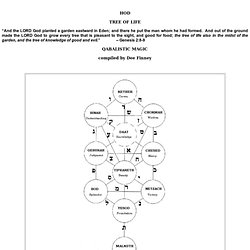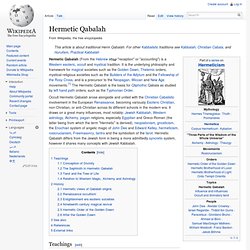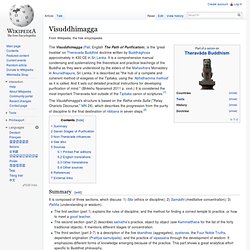

The Paradox of Choice - Why More Is Less. Esoteric. HOD. The word Qabbalah finds its root in the Hebrew word Qibel meaning 'to receive by oral tradition'.

Qabbalah refers to an oral tradition of esoteric or secret knowledge concerning 'essentially' the mysteries of Nature, and more overtly, the hidden teachings concerning the Hebrew Torah. The Torah is, of course, the first five books of what Christians call the Old Testament, and the oldest surviving of the Judaic liturgical texts. The Kabala is an ancient Hebrew mystical system of thought. It is a symbolic representation of the path the Divine followed in the creation of the universe, including man. It is, by definition, humanity's process of returning to divinity along the same path. Kabbala, also spelled KABALA, KABBALAH, CABALA, CABBALA, OR CABBALAH, is an esoteric Jewish mysticism as it appeared in the 12th and following centuries. It thus gave Judaism a religious dimension whose mystical approaches to God were viewed by some as dangerously pantheistic and heretical. FROM: FROM: Sacred Geometry - Part 1.
Hermeticism. Hermetic Qabalah. Teachings[edit] Conception of Divinity[edit] A primary concern of Hermetic Qabalah is the nature of divinity, its conception of which is quite markedly different from that presented in monotheistic religions; in particular there is not the strict separation between divinity and humankind which is seen in monotheisms.[2] Hermetic Qabalah holds to the neoplatonic conception that the manifest universe, of which material creation is a part, arose as a series of emanations from the godhead.[3] The Sephiroth in Hermetic Qabalah[edit] From Ain Suph Aur crystallises Kether, the first sephirah of the Hermetic Qabalistic tree of life.

From Kether emanate the rest of the sephirot in turn, viz. Each sephirah is a nexus of divine energy and each has a number of attributions. Tarot and the Tree of Life[edit] Hermetic Qabalists see the cards of the tarot as keys to the Tree of Life. Relation to Western Magic, Alchemy and Astrology[edit] Quabalistic Tree of Life. Aleister Crowley. Visuddhimagga. The Visuddhimagga (Pali; English The Path of Purification), is the 'great treatise' on Theravada Buddhist doctrine written by Buddhaghosa approximately in 430 CE in Sri Lanka.

It is a comprehensive manual condensing and systematizing the theoretical and practical teachings of the Buddha as they were understood by the elders of the Mahavihara Monastery in Anuradhapura, Sri Lanka. It is described as "the hub of a complete and coherent method of exegesis of the Tipitaka, using the ‘Abhidhamma method' as it is called. And it sets out detailed practical instructions for developing purification of mind.
" (Bhikkhu Nyanamoli 2011 p. xxvii.) It is considered the most important Theravada text outside of the Tipitaka canon of scriptures.[1] Summary[edit] It is composed of three sections, which discuss: 1) Sīla (ethics or discipline); 2) Samādhi (meditative concentration); 3) Pañña (understanding or wisdom). Seven Stages of Purification[edit] Non-Theravada influences[edit] See also[edit] Sources[edit]